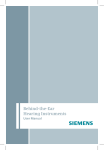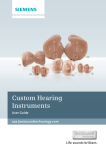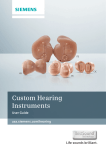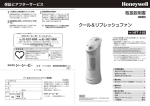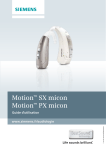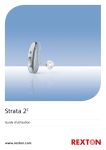Download Siemens hearing systems User manual
Transcript
Receiver-in-Canal Hearing Instruments User Manual Thank you for purchasing a Siemens Hearing Instrument. Siemens Hearing Instruments are designed to achieve the highest in quality and reliability. We are sure that you will be very pleased with our product. If this Hearing Instrument is being purchased for an infant or young child, please confirm with your Audiologist or Hearing Care Provider that it is recommended for this purpose and to ensure appropriate supervision and use of the product. Hearing Aid Information Serial Number: Left: Right: Battery Size: Left: Right: Purchase Date: Left: Right: Dispenser Info stamped here Table of Contents Getting Started Your hearing instruments . . . . . . . . . . . . . . . . . . . . . . . . . . 4 Safety information . . . . . . . . . . . . . . . . . . . . . . . . . . . . . . . 5 Feature card . . . . . . . . . . . . . . . . . . . . . . . . . . . . . . . . . . . . 6 Identification information . . . . . . . . . . . . . . . . . . . . . . . . . . 7 Identifying the left and right hearing instrument(s) . . . . . 8 Changing the battery . . . . . . . . . . . . . . . . . . . . . . . . . . . . . 9 Handling the standard and rechargeable batteries . . . . . 11 Battery tips . . . . . . . . . . . . . . . . . . . . . . . . . . . . . . . . . . . . 11 Using the charger . . . . . . . . . . . . . . . . . . . . . . . . . . . . . . . 12 Turning the hearing instrument on or off . . . . . . . . . . . . 13 Inserting and removing . . . . . . . . . . . . . . . . . . . . . . . . . . 14 Operating Your Hearing InstrumentOptional Features Changing the volume . . . . . . . . . . . . . . . . . . . . . . . . . . . . 15 Learning volume preference feature . . . . . . . . . . . . . . . . 16 SoundLearning™ feature . . . . . . . . . . . . . . . . . . . . . . . . . . 16 Changing the program . . . . . . . . . . . . . . . . . . . . . . . . . . . 16 Directional microphone system . . . . . . . . . . . . . . . . . . . . 18 Operating Your Hearing InstrumentProgrammable Features Wireless functionality . . . . . . . . . . . . . . . . . . . . . . . . . . . . 20 Push button on/off . . . . . . . . . . . . . . . . . . . . . . . . . . . . . . 22 Power on delay . . . . . . . . . . . . . . . . . . . . . . . . . . . . . . . . . 22 Low battery indicator . . . . . . . . . . . . . . . . . . . . . . . . . . . . 22 Volume control alert tones . . . . . . . . . . . . . . . . . . . . . . . 23 Program change alert tones . . . . . . . . . . . . . . . . . . . . . . . 23 Listening Tips . . . . . . . . . . . . . . . . . . . . . . . . . . 24 Maintenance and Care . . . . . . . . . . . . . . . . . . 26 Using the domes . . . . . . . . . . . . . . . . . . . . . . . . . . . . . . . . 27 Cleaning instructions for domes . . . . . . . . . . . . . . . . . . . . 28 Replacing the dome (non click dome receivers) . . . . . . . 29 Replacing the dome (click dome receivers) . . . . . . . . . . . 30 Replacing the receiver unit . . . . . . . . . . . . . . . . . . . . . . . . 31 Performance Checklist . . . . . . . . . . . . . . . . . . 32 Health Considerations . . . . . . . . . . . . . . . . . . 33 Important Notices . . . . . . . . . . . . . . . . . . . . . . 34 Warranty and Service . . . . . . . . . . . . . . . . . . . 38 2 TABLE OF CONTENTS TABLE OF CONTENTS 3 Getting Started Toggle Switch Your hearing instruments Microphone Cover As the owner of Siemens hearing instruments you may once again enjoy the sounds of the environment and conversation with your family and friends. Your decision to purchase Siemens hearing instruments reflects the importance you place on quality and reliability. Siemens hearing instruments are designed for comfort and performance in a virtually invisible style (when worn). The hearing instruments offer an assortment of receiver lengths and dome sizes to best fit your ear. Your instrument will look similar to the following illustrations (Fig. 1 and 2). Charging Contact Receiver Unit Fig. 2: Location of features Safety information Caution: Risk of injury caused by incorrect use of domes. • Always wear the receiver unit with the dome. Program Button Microphone Cover • Make sure that the dome is completely attached to the receiver unit. • If the dome remains in the ear after removal of your hearing instrument, have it removed by a medical professional. Charging Contact • Replace the dome if it breaks. • Do not insert the receiver and dome too deeply in your ear. Speak with your Audiologist or Hearing Care Provider for further explanation. Receiver unit Fig. 1: Location of features 4 GETTING STARTED GETTING STARTED 5 WARNING Identification information Choking hazard posed by small parts. • Keep hearing instruments, batteries and accessories out of children’s reach. • If swallowed consult a physician or hospital immediately. • If infants, small children or mentally disabled persons need to wear hearing instruments ensure adequate supervision. WARNING Risk in explosive environments, e.g., mining areas • Don’t use your hearing instruments (and remote control) in areas where there is danger of explosions. t Please read this manual carefully to benefit from all the features of your new hearing system. Your hearing instruments have a serial number engraved on them. The location of the serial number will vary according to the style of hearing instrument you have chosen. Record the serial number in the front of this manual for future reference (Fig. 3) The year of manufacture is incorporated into the serial number. Please note the warranty is based upon the date of purchase, not the date of manufacture. The serial number may look similar to this sample: AY12345. The second letter of this serial number refers to the year of manufacture of the hearing instrument. The letters Y and A indicate a 2011 year of manufacture. Your Audiologist or Hearing Care Provider can answer any questions you may have about the identifying code on your hearing instrument. Feature card AY12345 Please refer to the feature card included with this manual. The feature card is located at the back of this user manual in a pocket. Serial number Fig. 3: Identification information The feature card contains important information about the features in your new hearing instruments. This includes battery size, serial number location, and features associated with the operation of your new hearing instruments. More information about these features is located in the Operation section of this manual. 6 GETTING STARTED GETTING STARTED 7 Changing the battery Identifying the left and right hearing instrument(s) Your Siemens hearing instruments may be color-coded for your convenience. The left ear hearing instrument may have a blue ring on the receiver unit, and the right ear hearing instrument may have a red ring on the receiver unit (Fig. 4). Refer to the feature card or check with your Audiologist or Hearing Care Provider to determine the battery size for your hearing instrument. To insert the battery into the hearing instrument, open the battery compartment with your fingernail as shown (Fig. 6). Red ring - RIGHT Ear Blue ring - LEFT Ear Fig. 4: Identification information Alternatively, the left hearing instrument may have a blue dot where the receiver unit attaches to the hearing instrument, and the right hearing instrument may have a red dot where the receiver unit attaches to the hearing instrument (Fig. 5). Red dot - RIGHT Ear Blue dot - LEFT Ear Fig. 6: Opening the battery compartment Swivel open the battery compartment door. Insert the proper size battery into the compartment door so that the “+” symbol on the battery coincides with the “+” marked on the battery compartment (Fig. 7). Fig. 5: Identification information Fig. 7: Inserting the battery 8 GETTING STARTED GETTING STARTED 9 Close the battery compartment by gently pressing the bottom of the door upward with your fingertip. Do not force the door shut. If it does not close easily, check to ensure the battery was inserted properly (Fig. 8). Handling standard and rechargeable batteries You can use either a standard or a rechargeable battery in your hearing instrument. The optional charger is required to charge rechargeable batteries. If using a standard battery, remove the backing tab only when you are ready to use it. If using a rechargeable battery, charge it before the first use. Battery tips Fig. 8: Closing the battery compartment The battery should easily drop out when the compartment door is completely open (Fig. 9). If the battery does not come out, lightly tap on the case. • If a battery is accidentally swallowed, seek medical attention immediately, or call the National Battery Hotline collect at (202) 625-3333. Quebec residents, call le Centre Antipoison at (800) 463-5060. • Always use the recommended battery size for your hearing instrument. The battery size information for your hearing instrument is located on the feature card. • Remove the battery from your instruments when not in use. This prevents possible damage from expansion or leakage of the battery, if the instruments are not fully turned off. • Always carry spare batteries in the event that your current battery goes dead. Place each spare battery in an individual, non-metallic container to prevent contact with other batteries or metal objects, such as keys or coins. Fig. 9: Removing the battery • . Follow your local recycling rules for battery disposal. Your hearing instrument may be programmed to inform you when the battery should be replaced. Refer to the low battery indicator information in the Operation section (page 20) of this manual for further information. 10 GETTING STARTED GETTING STARTED 11 Using the charger Turning the hearing instrument on or off If you have the optional charger, refer to the charger instruction manual for operating instructions. Use only the rechargeable batteries delivered with the charger or available through your Audiologist or Hearing Care Provider. The lifetime of a rechargeable battery is approximately one year, depending on individual use. To turn the hearing instrument on, insert a battery into the hearing instrument and completely close the door. To turn the hearing instrument off, open the battery door to the first catch (Fig. 11). NOTE: Do not attempt to charge standard, non-rechargeable batteries! NOTE: The hearing instrument must be turned off then on after removing from the charger. This is required to turn the instrument on. On Off Fig. 11: Turning the instrument on and off Fig. 10: Charger 12 GETTING STARTED GETTING STARTED 13 Inserting and removing To insert the hearing instrument, make sure it is turned off by opening the battery compartment to the first stop. Hold the receiver with the dome or earmold between your thumb and index finger and insert it carefully into the ear canal (Fig. 12). Operating Your Hearing Instrument–Optional Features Refer to the feature card included with this manual to determine the optional features your hearing instrument is equipped with (Fig. 13). HEARING INSTRUMENT Battery options shown below Clip-on microphone cover rechargeable Receiver unit Optional Features Dome FEATURE CARD Charging contact OPTIONAL FEATURES Learning volume preference Directional microphone Rechargeable battery ePocket® remote control Battery compartment PROGRAMMABLE FEATURES e2e wireless® Power on delay Low battery indicator Volume control alert tones Program change alert tones PROGRAMS Program number Listening environment 1 2 3 Fig. 12: Inserting the instrument You may find it helpful to pull your ear slightly upward or backward when inserting your instrument. Then place the instrument behind your ear and turn it on, by completely closing the battery compartment. To remove your hearing instrument, hold the receiver unit between your thumb and index finger and carefully pull it out. 14 GETTING STARTED 4 Refer to the Active User Manual for information on Optional Features and Programmable Features. Fig. 13: FEATURE CARD Optional features section circled Changing the volume Your Siemens hearing instrument is fully automatic. However, you may have received an optional remote control with your hearing instrument. Press the Volume Up (+) button on the remote to increase the volume. Press the Volume Down (-) button on the remote to reduce the volume. Your hearing instrument may have a toggle switch. To change the volume using the toggle switch, push it up to increase the volume or down to decrease the volume. OPERATING YOUR HEARING INSTRUMENT-OPTIONAL FEATURES 15 Learning volume preference feature (if applicable) The learning volume feature retains information on when and how you adjust the volume on your Siemens hearing instruments programmed for manual adjustment. Over time, your hearing system will automatically adjust to that preferred volume in each listening program. For more information about this feature, speak with your Audiologist or Hearing Care Provider. SoundLearning™ feature (if applicable) SoundLearning allows all the functionality of the learning volume control preference feature above and also retains your sound quality preferences independently for loud and soft sounds. For more information about this feature, speak to your Audiologist or Hearing Care Provider. Changing the program Your Siemens hearing instrument may have several memories, also called hearing programs. Each program is different and designed to help you hear better in specific listening situations. Your hearing instrument may have a program button on the housing (fig. 14). Press the program button to change the program. 16 OPERATING YOUR HEARING INSTRUMENT-OPTIONAL FEATURES Program Button Toggle Switch Fig. 14: Changing the program with the program button or toggle switch When initially turned on (after the battery compartment door is closed), the microphone is ON and ready for general use. The default is Program 1. Your Audiologist or Hearing Care Provider will provide you with the number of programs most appropriate for your needs. Each time you press the program button on the hearing instrument (if available) or optional remote control the instrument changes to the next program. The program change may be confirmed by alerting tones or beeps that correlate to the program you are in. That means if you select Program 3, then the hearing instrument beeps 3 times. Your Audiologist or Hearing Care Provider may list your personal programs on the feature card (Fig. 15). OPERATING YOUR HEARING INSTRUMENT-OPTIONAL FEATURES 17 HEARING INSTRUMENT Battery options shown below Clip-on microphone cover rechargeable Receiver unit Dome Charging contact OPTIONAL FEATURES Learning volume preference Directional microphone Rechargeable battery ePocket® remote control Programs FEATURE CARD Battery compartment PROGRAMMABLE FEATURES e2e wireless® Power on delay Low battery indicator Volume control alert tones Program change alert tones PROGRAMS Program number Operating Your Hearing Instrument–Programmable Features Listening environment 1 Refer to the feature card included with this manual to determine the programmable features your hearing instrument is equipped with. Programmable features are listed on the right column of the feature card (Fig. 16): 2 3 4 Refer to the Active User Manual for information on Optional Features and Programmable Features. Fig. 15: FEATURE CARD Programs section circled HEARING INSTRUMENT Battery options shown below Clip-on microphone cover rechargeable Receiver unit Dome Charging contact OPTIONAL FEATURES Learning volume preference Directional microphone Rechargeable battery ePocket® remote control Directional microphone system According to your hearing needs, your Siemens hearing instrument can be adjusted to focus on sounds in front of you (directional mode) for when you are having a face-toface conversation in a noisy environment. The hearing system can also be adjusted for when you are in more quiet environments and want to hear the sounds around you (omnidirectional). Your Audiologist or Hearing Care Provider may program the operation of the directional microphone system to function automatically or in conjunction with the remote control based on your particular hearing requirements. 18 OPERATING YOUR HEARING INSTRUMENT-OPTIONAL FEATURES FEATURE CARD Battery compartment PROGRAMMABLE FEATURES e2e wireless® Power on delay Low battery indicator Volume control alert tones Program change alert tones Programmable Features PROGRAMS Program number Listening environment 1 2 3 4 Refer to the Active User Manual for information on Optional Features and Programmable Features. Fig. 16: FEATURE CARD Programmable features section circled OPERATING YOUR HEARING INSTRUMENT-PROGRAMMABLE FEATURES 19 Wireless functionality (if applicable) Your hearing instrument may be equipped with wireless functionality. This provides synchronization between two hearing instruments. If you change the program or volume on one instrument, the other is automatically changed. In addition, wireless technology automatically adjusts the system to change both hearing instruments simultaneously to adapt to different listening situations. The wireless functionality also enables use of an optional remote control. Note: The performance of the wireless functionality could be temporarily affected when in close proximity to electromagnetic noise sources, such as a computer monitor or television. Move away from the noise source if you experience difficulty. Technical information for e2e wireless function: Operating frequencies: flow = 115 kHz, fhigh = 120 kHz; Rated H-field strength (maximum): –11,5 dB µA/m at 3 meters. This Category II radiocommunication device complies with Industry Canada Standard RSS-310 and part 15 of the FCC rules. Operation is subject to the following two conditions: (1) this device may not cause interference, and (2) this device must accept any interference, including interference that may cause undesired operation of the device. The above applies to CENTRA® Active and CIELO® 2 Active. All other remote control compatible receiver-in-canal hearing instruments use e2e wireless 2.0. This equipment has been tested and found to comply with the limits for a Class B digital device, pursuant to Part 15 of the FCC Rules. These limits are designed to provide reasonable protection against harmful interference in a residential installation. This equipment generates, uses and can radiate radio frequency energy and, if not installed and used in accordance with the instructions, may cause harmful interference to radio communications. However, there is no guarantee that interference will not occur in a particular installation. If this equipment does cause harmful interference to radio or television reception, which can be determined by turning the equipment off and on, the user is encouraged to try to correct the interference by one or more of the following measures: • Reorient or relocate the receiving antenna. • Increase the separation between the equipment and receiver. • Connect the equipment into an outlet on a circuit different from that to which the receiver is connected. • Consult the dealer or an experienced radio/TV technician for help. Technical information for e2e 2.0 wireless function: Operating frequency : Fc = 3.28 MHz; Maximum field strength: –7 dB µA/m at 10m meters. This Class B digital apparatus II radiocommunication device complies with Industry Canada Standard RSS-210 and part 15 of the FCC rules. Operation is subject to the following two conditions: (1) this device may not cause interference, and (2) this device must accept any interference, including interference that may cause undesired operation of the device. FCC ID: SGI-WL002BTE, IC: 267AB-WL002 20 OPERATING YOUR HEARING INSTRUMENT-PROGRAMMABLE FEATURES OPERATING YOUR HEARING INSTRUMENT-PROGRAMMABLE FEATURES 21 Push button on/off Volume control alert tones Your Siemens hearing instruments may be programmed to allow you to turn them on and off using the program button. To turn the instrument off using the program button, press and hold the button for 3–5 seconds. To turn it back on, press and hold the program button for 3–5 seconds. Please note that after having turned the hearing instrument off using the program button, you must wait approximately 10 seconds for the system to reset before turning it back on again by using the program button. Your hearing instrument may be programmed to inform you of changes to volume. You may hear soft beeps each time you change the volume and a three beep warning when the volume limit has been reached. Once the maximum or minimum volume has been reached, further changes in that direction will have no effect. Power on delay Your hearing instruments may be equipped with an advanced power-on delay feature. This feature delays sound from entering your hearing instruments when they are first turned on so that you may insert the instruments into your ears without experiencing unpleasant feedback (whistling). Program change alert tones Your hearing instrument may be programmed to inform you of changes to the program. The program change may be confirmed by alert tones or beeps that correlate to the program you are in. That means if you select Program 3, the hearing instrument will beep 3 times. Low battery indicator Your hearing instrument may be programmed to inform you when the battery should be replaced for best performance. You may hear an intermittent series of beeps and/or experience low amplification power or volume. Change the battery immediately if either of these should occur. 22 OPERATING YOUR HEARING INSTRUMENT-PROGRAMMABLE FEATURES OPERATING YOUR HEARING INSTRUMENT-PROGRAMMABLE FEATURES 23 Listening Tips • Encourage one person to speak at a time when you are engaging in group conversation. • Give yourself time to become accustomed to your new hearing instruments. During this period, you may prefer to wear your hearing instruments for only a portion of the day, and then gradually increase your usage throughout your normal routine each day. • You may find that a quiet environment is more comfortable in the beginning of the adjustment period. Gradually introduce new listening environments as your ears become accustomed to hearing instrument amplification. • Listen to radio and television programs as you normally would. • Experiment finding the best place to sit for optimum hearing in public places like the theater, school auditoriums, religious services, etc. If possible, choose a seat that is far away from any source of distracting noise, such as a fan or an open window, and where you have a good view of the person speaking. • If you are a new hearing instrument user, be aware that there are sounds, both pleasant and unpleasant, that you may not have heard in a long time. • Ask the people with whom you are conversing to attract your attention before speaking to you. If you don’t understand what someone has said, ask the speaker to slow down or say it in another way, but not to shout. • In noisy or difficult environments, you may find it easier to understand speech by facing the speaker. Focus on reading lips and observing facial expressions and body language. Be aware that in some situations, it may be too noisy to understand what is being said. 24 LISTENING TIPS LISTENING TIPS 25 Maintenance and Care Hearing instruments should be cleaned daily. You can wipe them with a tissue or a soft cloth. Do not use water, alcohol, benzene, or any other liquid or household cleaning agent to clean your instruments as it may cause damage to them. • Do not expose your hearing instrument to extreme temperature or high humidity. • Do not leave it in direct sunlight. • Do not wear it in the shower or when you apply makeup, perfume, aftershave, hairspray or suntan lotion. Always store your hearing instruments (and Receiver Unit) inside the case. • Do not wear your hearing instruments when you are exposed to short-waves, a strong magnetic field, a high frequency field or X-rays. Remove the batteries to prevent damage from corrosion when storing hearing instruments for an extended period of time. Using the domes Store the instruments in a dry area, preferably at room temperature. If you perspire heavily or live in an area of high humidity, you may find it beneficial to use a DRI-AID™ kit when the instruments are not in use. This product can be purchased from your Audiologist or Hearing Care Provider. The dome includes an integrated wax protection system (Fig.17). For best results, it is recommended that you change your dome as needed. Wax protection in place Note: The charger can be used instead of the DRI-AID kit. Refer to the Maintenance and Care section of the charger instruction manual for further information. Never immerse your hearing instruments in water! Fig. 17: Using the dome Note: Your hearing instrument is sensitive to extreme heat, high humidity, strong magnetic fields (>0.1T), X-rays and mechanical stress. 26 MAINTENANCE AND CARE MAINTENANCE AND CARE 27 Cleaning instructions for domes Replacing the dome (non click dome receivers) Cerumen (ear wax) on the dome may affect sound quality. Listen for any changes in how your hearing instrument is performing. If wax has built up, it can be easily removed with the cleaning cloth or a soft tissue (Fig. 18). Do not use water, alcohol, benzene or any other liquid or household cleaning agent or liquid to clean your instruments or domes, as it may cause damage. Holding the receiver unit in one hand, grasp the dome between the thumb and index finger of your other hand. Then remove the dome from the receiver. Place the new dome on the receiver unit. Make sure it is secure before placing it in your ear (Fig. 19). Note: Never use sharp objects for cleaning, as they may damage the dome. Never use running water or immerse the instrument in water. Never use pressure or rotating action while cleaning. Fig. 19: Replacing the dome Caution: Do not place the receiver in your ear without the dome. Warning: If the dome becomes detached in your ear, contact your Audiologist or Hearing Care Provider or physician immediately. Fig. 18: Cleaning the dome 28 MAINTENANCE AND CARE MAINTENANCE AND CARE 29 Replacing the domes (click dome receivers) Exchanging domes The packaging of your dome has a slot on one side to remove the dome from the receiver. Replacing the receiver unit The receiver unit can be changed as needed by your Audiologist or Hearing Care Provider. If the receiver becomes detached from the instrument follow these instructions to reattach it. To join the receiver unit and amplifier, turn the receiver unit slightly to the left (Fig. 23). Insert and turn to the right to lock into place (Fig. 24). • Insert the receiver. • Tilt the receiver towards the packaging. • Click the tip of the receiver unit into the new dome. Fig. 23: Replacing the receiver unit click Exchanging double domes • Remove the used dome from the receiver. Fig. 24: Replacing the receiver unit • Click the tip of the receiver unit into the new dome. click It is not recommended to remove the receiver unit for everyday use. Your Audiologist or Hearing Care Provider will change the receiver unit as needed. Fig. 20: Domes 30 MAINTENANCE AND CARE MAINTENANCE AND CARE 31 Performance Checklist Problem Sound is weak Instrument emits whistling sound Sound is distorted Instrument does not work Cause Possible Solution Weak or dead battery Insert new standard battery or charge rechargeable battery Instrument clogged Clean instrument and/or change dome Volume too low Clean instrument and/or change dome Dome clogged with wax or debris Clean or change dome Microphone cover clogged Change microphone cover Improper seating in ear Try reinserting the receiver until it fits securely Volume too high Lower volume with the remote control Clogged with wax or excessive wax in ears Clean or change dome OR contact your Audiologist or Hearing Care Provider Volume too high Lower volume with the remote control Weak battery Charge or replace battery Instrument not turned on Open then close battery compartment Battery compartment not completely closed Gently close the battery compartment completely Dead battery Charge or replace battery Battery polarity reversed Make sure battery is inserted correctly Power-on delay is active Wait 15 seconds and check again Health Considerations If soreness or skin irritation develops, discontinue wearing your hearing instrument, and bring the instrument and earmold to your Audiologist or Hearing Care Provider. If soreness persists, discontinue wearing the hearing instrument and see your physician. If excessive earwax accumulates when wearing your hearing instruments, consult your Audiologist or Hearing Care Provider. If the solutions in this checklist do not address a particular issue you are having with your hearing instruments, consult your Audiologist or Hearing Care Provider. 32 PERFORMANCE CHECKLIST HEALTH CONSIDERATIONS 33 Important Notices Following the medical evaluation, the physician will give you a written statement that your hearing loss has been medically evaluated and that you may be considered a candidate for hearing instruments. Children with hearing loss In addition to seeing a physician for a medical evaluation, a child with a hearing loss should be directed to an Audiologist, since hearing loss may cause problems in language development and the educational and social growth of a child. An Audiologist is qualified by training and experience to assist in the evaluation and rehabilitation of a child with a hearing loss. Important notice for prospective hearing instrument wearers Good health practice requires that a person with a hearing loss have a medical evaluation by a licensed physician (preferably a physician who specializes in diseases of the ear) before purchasing hearing instruments. Licensed physicians who specialize in diseases of the ear are often referred to as Otolaryngologists, Otologists, or Otorhinolaryngologists. The purpose of a medical evaluation is to assure that all medically treatable conditions that may affect hearing are identified and treated before hearing instruments are purchased. 34 IMPORTANT NOTICES The physician will refer you to an Audiologist or Hearing Care Provider, as appropriate, for a hearing instrument evaluation. The Audiologist or Hearing Care Provider will conduct a hearing instrument evaluation to assess your ability to hear with and without hearing instruments. The hearing instrument evaluation will enable the Audiologist or Hearing Care Provider to select and fit hearing instruments for your individual needs. If you have reservations about your ability to adapt to amplification, you should inquire about the availability of a trial-rental or purchase-option program. Many Audiologists or Hearing Care Providers now offer programs that permit you to wear a hearing instrument for a period of time for a nominal fee after which you may decide if you want to purchase the hearing instrument. Only those fully informed adults who have either obtained medical evaluation from a licensed physician or signed a waiver statement declining the medical evaluation for religious or personal beliefs that preclude consultation with a physician may purchase hearing instruments. The exercise of such a waiver is not in your best health interest and its use is strongly discouraged. IMPORTANT NOTICES 35 Warning to Audiologists or Hearing Care Providers An Audiologist or Hearing Care Provider should advise a prospective hearing instrument user to consult promptly with a licensed physician (preferably an ear specialist) before dispensing a hearing instrument if the Audiologist or Hearing Care Provider determines through inquiry, actual observation, or review of any other available information concerning the prospective user that the prospective user has any of the following conditions: • Visible congenital or traumatic deformity of the ear. • Acute or chronic dizziness. • History of active drainage from the ear within the previous 90 days. Special care should be exercised in selecting and fitting a hearing instrument whose maximum sound pressure level exceeds 132 decibels (dB), because there may be risk of impairing the remaining hearing of the hearing instrument user. A hearing instrument will not restore normal hearing and will not prevent or improve a hearing impairment resulting from organic conditions. The use of hearing instruments is only part of hearing rehabilitation and may need to be supplemented by auditory training and instructions in lip reading. Consistent use of amplification is recommended. In most cases, infrequent use of hearing instruments does not permit the wearer to attain the full benefit of amplification. • History of sudden or rapidly progressive hearing loss within the previous 90 days. • Unilateral hearing loss of sudden or recent onset within the previous 90 days. • Audiometric air-bone gap equal to or greater than 15 decibels (dB) at 500 Hertz (Hz), 1000 Hz, and 2000 Hz. • Visible evidence of significant cerumen accumulation or a foreign body in the ear canal. • Pain or discomfort in the ear. 36 IMPORTANT NOTICES IMPORTANT NOTICES 37 Warranty and Service Your Siemens RIC hearing instrument, with the exception of the battery, is covered by a comprehensive warranty. All covered instrument parts received for warranty service at an authorized Siemens Service Center will be repaired or replaced with new or reconditioned components, without charge, to meet the performance specifications for that model. This warranty does not cover malfunctions due to unusual wear and tear or mistreatment of the instrument such as physical shock, excessive wax build-up, or tampering with the instrument, any of which voids all warranties. Your Audiologist or Hearing Care Provider may charge a service fee for processing warranty service. Warranty service must only be performed by an authorized Siemens Service Center. Service performed by unauthorized service depots voids this warranty and repairs so necessitated will be done on a parts and labor cost basis. Procedure In case of malfunction or loss, take your Siemens hearing instrument and/or proof of purchase to the Audiologist or Hearing Care Provider from whom the unit was purchased. If factory service or replacement is needed, your instrument will be sent to an authorized Siemens Service Center. Extended warranty programs Siemens offers extended warranty and service programs for your hearing instruments. Please consult with your Audiologist or Hearing Care Provider for more details on these programs. IMPORTANT This warranty gives you specific legal rights and you may have other rights which may vary from location to location. For more information, contact your local Department of Consumer Affairs. Please Refer to the warranty card included with your hearing instruments for warranty period effective dates. Your Siemens RIC hearing instruments may have additional loss and damage coverage. Please consult your Audiologist or Hearing Care Provider to determine if this is applicable to your hearing instruments. 38 WARRANTY AND SERVICE WARRANTY AND SERVICE 39 Information in this brochure is subject to change without notice. Copyright © 2011 Siemens Hearing Instruments, Inc. All rights reserved. Les renseignements contenus dans le présent guide peuvent faire l’objet de modifications sans préavis. Tous droits réservés © 2011 Siemens Hearing Instruments, Inc. Legal Manufacturer in Canada Siemens Hearing Instruments Inc. 320 Pinebush Road Cambridge, ON, N1T 1Z6 www.siemens.ca/hearing Siemens Appareils auditifs inc. 320 Pinebush Road Cambridge (Ontario) N1T 1Z6 www.siemens.ca/hearing Legal Manufacturer Siemens Audiologische Technik GmbH Gebberstrasse 125 91058 Erlangen Germany Global Business Unit Siemens Audiologische Technik GmbH Gebberstrasse 125 91058 Erlangen Germany Phone: +49 9131 308 0 Global Siemens Headquarters Siemens AG Wittelsbacherplatz 2 80333 Muenchen Germany Global Siemens Healthcare Headquarters Siemens AG Healthcare Sector Henkestrasse 127 91058 Erlangen Germany Phone: +49 9131 84 0 www.siemens.com/healthcare www.siemens.com/hearing 10295008 4/11 2.0 LC 3.0K SHI/11105-10






















